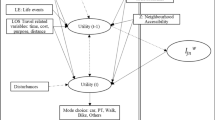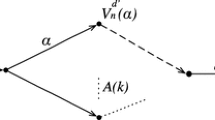Abstract
Methods of updating disaggregate discrete choice models have been proposed as a means of obtaining better transferability. However, the temporal transferability of models updated for better spatial transferability has rarely been analysed, and the factors affecting temporal transferability have not been determined. This paper deals with one updating method—the use of disaggregate data to update alternative-specific constants—and investigates the factors affecting the temporal transferability of the updated constants. In the analysis, repeated cross-section data collected in the Chukyo metropolitan area are divided, efficiently generating many application areas. The analysis showed that the factors can depend on regional characteristics and past travel behaviours (inertia), and are anti-symmetric and path-dependent of changes in the level of service.



Similar content being viewed by others
Notes
Each OD pair is part of the entire study area mentioned in step (1). The spatial transferability described in step (2) is not transferability to a completely different area, but is transferability in the broader sense. When practitioners analyse the transport behaviour of a specific OD pair, they sometimes develop models with samples from a much broader area that includes that OD, and update alternative-specific constants using the data for that OD. From this point of view, the insights described in this study are useful to practitioners.
Price data for transit service in 1991 were set to 400% of those in 1971, by taking into consideration changes in the fare for travelling 10 km and the starting fare. Fares based on reports published by the Japanese government. Price data for automobiles in 1991 were set to 200% of those in 1971, by taking into consideration changes in the petrol price and petrol mileage. Petrol price and mileage based on reports published by the Japanese government. Transit cost data were weighted averages based on the number of trip makers using rail and bus. A method for generating 1971 cost data seems less reliable, but the authors introduce it in order to exclude biases that may be included in the constant.
323.5 JPY/h in 1971 and 1,605.3 JPY/h in 1991 are used.
When both the utility scales and the alternative-specific constants are updated, the utility scale is subjected to a following t-test using Eqs. A1 and A2.
$$ {\frac{{\mu_{\text{od}}^{91} - \mu_{\text{od}}^{71} }}{{\left( {{\text{Var}}\left( {\mu_{\text{od}}^{91} } \right) + {\text{Var}}\left( {\mu_{\text{od}}^{71} } \right)} \right)^{1/2} }}} $$(A1)$$ {\frac{{\mu_{\text{od}}^{91} - 1}}{{\left( {\text{Var}\left( {\mu_{\text{od}}^{91} } \right)} \right)^{1/2} }}} $$(A2)where, \( \mu_{\text{od}}^{91} \) and \( \mu_{\text{od}}^{71} \) are the utility scales updated using 1991 and 1971 data, respectively, for OD pair od; \( {\text{Var}}\left( {\mu_{\text{od}}^{91} } \right) \) and \( {\text{Var}}\left( {\mu_{\text{od}}^{71} } \right) \) are the corresponding variances of the utility scales. The results are summarised in Appendix 2, which compares the updated utility scales using 1971 data and 1991 data (numbers without parentheses in Table 8 using Eq. A1) and the updated utility scales using 1991 data and the utility scale in the original model (that is, one) (numbers in parentheses in Table 8 using Eq. A2). Both results show that the updated utility scales are not rejected in the majority of OD pairs.
Mode choice models in this paper describe the cross-sectional state of the travel behaviours in 1971 and 1991. In the regression analysis, a dependent variable is the difference in the updated constants that are estimated in the model describing the cross-sectional state. Therefore, the inclusion of variables related to mode choice models does not pose any problems in the regression.
The regression analysis was conducted stepwise.
(1) One of the variables listed in Table 5 is included as an explanatory variable. Models are generated for three cases—50, 100, and 200 samples—and the model that provides the best adjusted R 2 is named the best model for each sample case. (The coefficient estimate for a variable must satisfy a 5% level of significance.) When the best models for the three cases are identical, that model is selected as the overall best model. When the best models for two of the three cases are identical, that model is selected as the overall best model. When the best models for the three cases all differ, an overall best model is not selected.
(2) The variable selected in the first step and one of the variables listed in Table 5 are included as explanatory variables. The best model for each case and the overall best model are selected in the same manner described in the first step. This process continues until the three cases have different best models.
(3) After the second step, another variable from Table 5 is included as an explanatory variable. If the coefficient estimates for the variables satisfy the 5% level of significance for all three cases, then this model is selected as the overall best model. This process continues until the additional variable does not satisfy the 5% level of significance for the three cases.
References
Atherton, T.J., Ben-Akiva, M.E.: Transferability and updating of disaggregate travel demand models. Transp. Res. Rec. 610, 12–18 (1976)
Badoe, D.A., Miller, E.J.: Analysis of the temporal transferability of disaggregate work trip mode choice models. Transp. Res. Rec. 1493, 1–11 (1995)
Ben-Akiva, M., Lerman, S.R.: Discrete Choice Analysis: Theory and Application to Travel Demand. MIT Press, Cambridge (1985)
Harata, N., Ohta, K.: Hishuukei rojitto moderu no tekiyousei ni kansuru kenkyuu—Tsuukin koutsuu shudan sentaku no baai—[A study on the application of disaggregate logit models—the case of commuting mode choice–]. Traffic Eng. 17(2), 15–23 (1982). (in Japanese)
Karasmaa, N., Pursula, M.: Empirical studies of transferability of Helsinki metropolitan area travel forecasting models. Transp. Res. Rec. 1607, 38–44 (1997)
Koppelman, F.S., Wilmot, C.G.: Transferability analysis of disaggregate choice models. Transp. Res. Rec. 895, 18–24 (1982)
McCarthy, P.S.: Further evidence on the temporal stability of disaggregate travel demand models. Transp. Res. 16B(4), 263–278 (1982)
Morichi, S.: Hishuukei koudou moderu ni yoru yosoku [Forecasting using disaggregate behaviour models]. In: Doboku gakkai doboku keikakugaku kenkyuu iinkai (ed.) [The infrastructure planning committee, Japan society of civil engineers (ed.)] Hishuukei koudou moderu no riron to jissai [Theory and practice of disaggregate behaviour models], Maruzen, Tokyo (1995). (in Japanese)
Morichi, S., Yai, T., Tamura, T.: Spatial transferability of disaggregate mode-choice models. J. Infrastruc. Manag. 359/IV-3, 107–115 (1985). (in Japanese)
Morikawa, T., Nagamatsu, Y., Sanko, N.: Post-project evaluation of the demand forecast for a new transit system. Transp. Policy Stud. Rev. 7(2), 20–29 (2004). (in Japanese)
Acknowledgments
The authors wish to thank the anonymous reviewers for their comments. This study is supported by a Grant-in-Aid for Scientific Research (Grant No. 21330103) from the Japan Society for the Promotion of Science.
Author information
Authors and Affiliations
Corresponding author
Rights and permissions
About this article
Cite this article
Sanko, N., Morikawa, T. Temporal transferability of updated alternative-specific constants in disaggregate mode choice models. Transportation 37, 203–219 (2010). https://doi.org/10.1007/s11116-009-9252-6
Published:
Issue Date:
DOI: https://doi.org/10.1007/s11116-009-9252-6




